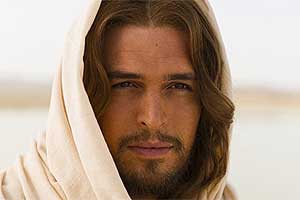
They say you can never be too rich or too thin. Surely it goes without saying that you can’t be too good-looking, either, right Especially in Hollywood.
But in the popular new film Son of God, Jesus is so, well, easy on the eyes that some are revisiting an age-old question that has vexed scholars for centuries:
Did Jesus really look like Brad Pitt, only slightly better
OK, that exact question hasn’t vexed scholars for centuries. But those who study religion as portrayed in popular culture do note that depicting Jesus on the screen has always been a tricky business, one that balances weighty theological concerns – how divine to make the son of God, and how human -with more earthly ones, like how best to sell movie tickets
“Listen, films are big business,” says Steven Kraftchick, professor at Emory University’s Candler School of Theology. “They’re probably not going to cast Jonah Hill as Jesus.”
Not that Hill wouldn’t provide an interesting spin. But the producers of Son of God, Roma Downey (who also plays Jesus’ mother Mary) and her husband Mark Burnett, were clearly going for something different when they chose the strapping, 1.90 metres Diogo Morgado, a Portuguese actor who’s dabbled in modelling, for The Bible, their History channel miniseries. (Son of God is culled from footage shot for the series).
Downey won’t deny her Jesus is good-looking – not that she’d get very far with that – but explains she was seeking a subtle mix of qualities. “Someone with strength, presence, charisma, tenderness, kindness, compassion and natural humility,” she says. “Someone who could be both a lion AND a lamb.”
Casting came down to the wire. A few weeks before shooting was to begin in Morocco, there was still no Jesus. Downey fired off an email to church and business contacts with the urgent header: “Looking for Jesus.”
Salvation came from an unexpected place. In Ouarzazate, Morocco, a member of an advance team remembered an actor who’d been there more than a year earlier on a different project. He searched through hotel registries and found the name.
Not surprisingly, Morgado’s looks have been a big part of the conversation ever since. “We not only found Jesus, we found Hot Jesus,’ Oprah Winfrey told him in a TV interview, referring to a Twitter hashtag about the actor.
“A hunkier Jesus than necessary,” Variety noted in its review of the movie. The Hollywood Reporter called it “Jesus as pretty boy,” and noted a resemblance between Morgado and the young Marlon Brando.
But box office is booming. “Son of God” came in a close second last weekend to Liam Neeson’s “Non-Stop,” beating out the blockbuster “Lego” movie.
To Morgado, it’s all good. “Long after I’m gone, this is going to be my legacy,” he said in a telephone interview. “So why should I worry about people calling me ‘Hot Jesus’ I’m really proud of this movie.”
His key acting challenge, Morgado notes, was getting that balance between divine and human: “It’s a really tricky thing.”
That’s always been a problem, says Jeffrey Mahan, professor at the Iliff school of theology in Denver. “Jesus films go back to the very beginning of cinema, and there’s always that tension between human and divine.”
Ad Feedback
Mahan notes that “this isn’t the first sexy Jesus on film.” When Jeffrey Hunter played the role in the 1961 King of Kings, he says, people dismissively dubbed it “I Was a Teenage Jesus,” a reference to Hunter’s youthful good looks (though he was in his 30s).
Some films, like the 1959 Ben-Hur, avoided problems by not showing Jesus’ face. Others, says Adele Reinhartz, author of Jesus in Hollywood and professor at the University of Ottawa, show a sanitised figure “that could have walked right out of a Renaissance painting.” But they were always fairly good-looking: “These are marketing decisions.”
The deeper problem with portraying Jesus, Reinhartz says, is that “to make a compelling movie character, you need flaws. And that doesn’t fit into most conceptions of Jesus.”
One exception was Martin Scorsese’s 1988 The Last Temptation of Christ, starring Willem Dafoe as a Jesus conflicted about his identity and experiencing earthly temptations, like lust. That didn’t please everyone – a Christian fundamentalist group hurled Molotov cocktails at a Paris theater where it played.
Then there was Mel Gibson’s 2004 The Passion of the Christ, starring Jim Caviezel, an enormous hit which is deemed one of the most controversial films of all time, both because of its bloody depiction of the Crucifixion – Roger Ebert called it the most violent film he’d ever seen – and allegations of anti-Semitism.
Caviezel, Dafoe, Morgado – all give different interpretations, but they all look a certain way. None, for example, are dark-skinned, as some have speculated Jesus was. Others have noted that men of the time were significantly smaller than they are today.
“The fact is we just don’t know how Jesus looked,” says Kraftchick, at Emory. “How big was he Did he have a speech defect”
Downey, asked about the issue, points out that her Jesus is a Latino, and that in itself is groundbreaking. (The film is also being released in Spanish.)
What troubles Mahan is that heartthrob Jesus portrayals ignore that “Jesus was an outsider. And this ‘pretty Jesus’ is an attempt to make him sort of a celebrity. That isn’t accurate according to the tone of the Gospels.
Morgado says he’s taking the long view.
“When I was in Jerusalem, I saw a man and a 10-year-old kid praying,” he says. “And I looked at the kid and thought, ‘Wow, I will be his visual and spiritual reference.”
That’s what producers are hoping.
“I think people who don’t know Jesus will fall in love,” Downey says. “And those who do know him will fall in love all over again.”
– AP